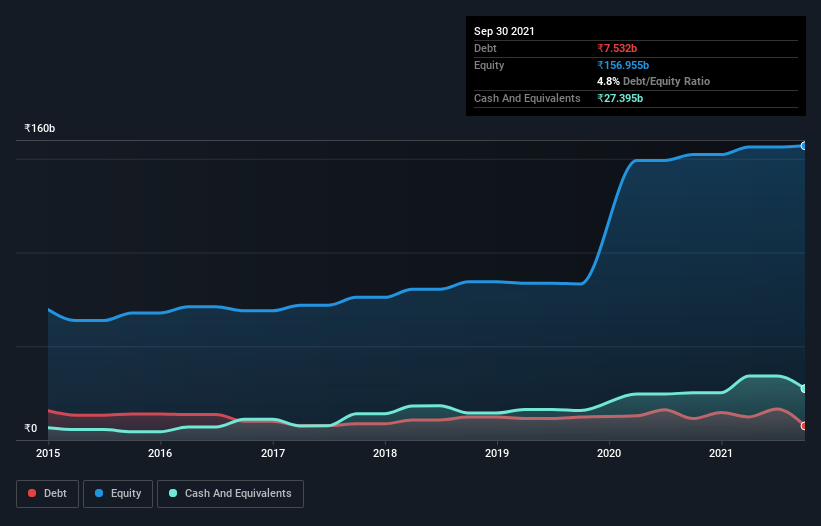Tata Consumer Products (NSE:TATACONSUM) Seems To Use Debt Quite Sensibly

Howard Marks put it nicely when he said that, rather than worrying about share price volatility, 'The possibility of permanent loss is the risk I worry about... and every practical investor I know worries about.' It's only natural to consider a company's balance sheet when you examine how risky it is, since debt is often involved when a business collapses. We can see that Tata Consumer Products Limited (NSE:TATACONSUM) does use debt in its business. But the real question is whether this debt is making the company risky.
When Is Debt A Problem?
Generally speaking, debt only becomes a real problem when a company can't easily pay it off, either by raising capital or with its own cash flow. In the worst case scenario, a company can go bankrupt if it cannot pay its creditors. However, a more common (but still painful) scenario is that it has to raise new equity capital at a low price, thus permanently diluting shareholders. Of course, the upside of debt is that it often represents cheap capital, especially when it replaces dilution in a company with the ability to reinvest at high rates of return. When we think about a company's use of debt, we first look at cash and debt together.
See our latest analysis for Tata Consumer Products
What Is Tata Consumer Products's Net Debt?
As you can see below, Tata Consumer Products had ₹7.53b of debt at September 2021, down from ₹11.4b a year prior. But it also has ₹27.4b in cash to offset that, meaning it has ₹19.9b net cash.

A Look At Tata Consumer Products' Liabilities
According to the last reported balance sheet, Tata Consumer Products had liabilities of ₹25.1b due within 12 months, and liabilities of ₹15.9b due beyond 12 months. Offsetting these obligations, it had cash of ₹27.4b as well as receivables valued at ₹8.77b due within 12 months. So its liabilities outweigh the sum of its cash and (near-term) receivables by ₹4.79b.
Having regard to Tata Consumer Products' size, it seems that its liquid assets are well balanced with its total liabilities. So while it's hard to imagine that the ₹681.5b company is struggling for cash, we still think it's worth monitoring its balance sheet. Despite its noteworthy liabilities, Tata Consumer Products boasts net cash, so it's fair to say it does not have a heavy debt load!
But the other side of the story is that Tata Consumer Products saw its EBIT decline by 3.1% over the last year. That sort of decline, if sustained, will obviously make debt harder to handle. The balance sheet is clearly the area to focus on when you are analysing debt. But ultimately the future profitability of the business will decide if Tata Consumer Products can strengthen its balance sheet over time. So if you want to see what the professionals think, you might find this free report on analyst profit forecasts to be interesting.
Finally, a company can only pay off debt with cold hard cash, not accounting profits. While Tata Consumer Products has net cash on its balance sheet, it's still worth taking a look at its ability to convert earnings before interest and tax (EBIT) to free cash flow, to help us understand how quickly it is building (or eroding) that cash balance. During the last three years, Tata Consumer Products generated free cash flow amounting to a very robust 93% of its EBIT, more than we'd expect. That puts it in a very strong position to pay down debt.
Summing up
While it is always sensible to look at a company's total liabilities, it is very reassuring that Tata Consumer Products has ₹19.9b in net cash. The cherry on top was that in converted 93% of that EBIT to free cash flow, bringing in ₹14b. So is Tata Consumer Products's debt a risk? It doesn't seem so to us. Over time, share prices tend to follow earnings per share, so if you're interested in Tata Consumer Products, you may well want to click here to check an interactive graph of its earnings per share history.
When all is said and done, sometimes its easier to focus on companies that don't even need debt. Readers can access a list of growth stocks with zero net debt 100% free, right now.
Valuation is complex, but we're here to simplify it.
Discover if Tata Consumer Products might be undervalued or overvalued with our detailed analysis, featuring fair value estimates, potential risks, dividends, insider trades, and its financial condition.
Access Free AnalysisHave feedback on this article? Concerned about the content? Get in touch with us directly. Alternatively, email editorial-team (at) simplywallst.com.
This article by Simply Wall St is general in nature. We provide commentary based on historical data and analyst forecasts only using an unbiased methodology and our articles are not intended to be financial advice. It does not constitute a recommendation to buy or sell any stock, and does not take account of your objectives, or your financial situation. We aim to bring you long-term focused analysis driven by fundamental data. Note that our analysis may not factor in the latest price-sensitive company announcements or qualitative material. Simply Wall St has no position in any stocks mentioned.
About NSEI:TATACONSUM
Tata Consumer Products
Produces, distributes, and trades in food products in India, the United States, the United Kingdom, and internationally.
Excellent balance sheet established dividend payer.


